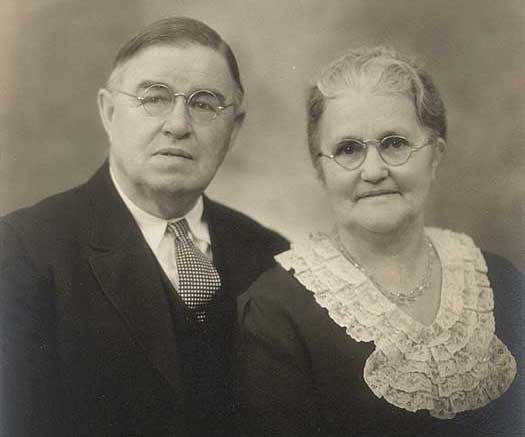LAKE GOGEBIC IN THE EARLY DAYS
Descendants of Albert Tillner (Many of whom are mentioned herein) |
|
|
|
|
|
1 Albert Tillner |
|
In 1920, Lake Gogebic (Indian word pronounced Go-gi’-bic) in the west end of the Upper Peninsula (UP) of Michigan was pretty much a wilderness area. There was an access road to the south end of the lake where the Gogebic County Park was located and criss-crossing logging roads but little else. The County Park boasted a cleared area for camping, a dock, and a large boathouse. Albert Tillner (my mother’s father) rented a slip in that boathouse and kept a 24’ launch with an inboard engine that the family used for fishing and recreation.
At about that time Albert acquired a lot with lake frontage about a mile from the park on the west shore of Lake Gogebic, and he set about developing it. The property had ample second growth forest so logs and rough lumber were readily available, but every item of finished lumber, roofing, hardware, furniture and supplies had to be trucked to the park, offloaded to the launch, motored to the property, and carried up the hill to the site of the new cottage.
The family slept out on the ground while a basic cottage was assembled. This consisted of a single room about 15’ square. A 2-hole outhouse was built, probably before anything else. A root cellar was made to help preserve butter, milk, etc. Initially water was simply dipped from the lake for dishes, bathing, etc., but drinking water was hauled by boat from an artesian well at White City, a resort on the south end of the lake. Later, a neighbor two cottages south (Sher from Ironwood) dug a well and shared with his neighbors. Still later Albert dug a well near the root cellar and struck good water at 18’.
A very sturdy boathouse was constructed with heavy logs and timbers to withstand the winter weather and thick ice. A manual winch served to raise the boat out of the water for storage and protection from the winter freeze. A dock parallel to the shore was made with two huge logs about 3’ apart connected with 1” metal bolts. The space between the logs was filled with boulders and sand while planks made the walking area.
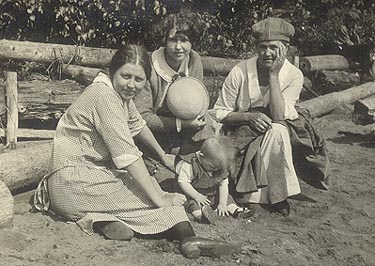
Beda, Edna, Grandma Tillner and Charlotte
~1924 as boathouse was being built
Over time the basic cottage was improved dramatically. Bedrooms were added to the west side, a kitchen was added to the south side, a large screened porch was constructed on the east side facing the lake, and eventually the roof of the basic cottage was raised to add sleeping area on a second floor. The kitchen had a wood range complete with a big oven, a large reservoir for a supply of hot water, and warming ovens above. Two 14-quart pails by the sink provided “running water”. One dipper served everyone, germs be damned.
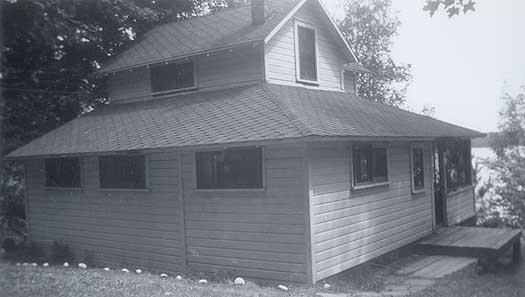
Bedrooms – 2 windows on left, kitchen – 1w on
right
and 2w on right side, porch – facing lake, second floor – up
Around 1930, an access road was put in paralleling the west side of the lake. At that time, Albert added a driveway from the road to the cottage. The elevation change from the road to the cottage was large and the driveway was treacherous. Albert added a garage just off the road. At some point someone broke in to the garage and siphoned gas from the vehicle parked there. Soon after Albert moved the garage down closer to the cottage and made it into a tool shed. The garage was very narrow, barely suitable for cars of the era.
The access road also made the heavy duty 24’ launch unnecessary. It was then cut down to an 18’ boat and used for many years for fishing and recreation. The inboard engine was removed and replaced by an Elto outboard with a knuckle-buster flywheel crank on top.
Also around 1930, Albert built a smaller cottage west of the main building. The initial building had a garage and storage area at one end, a large multi-function room on the lake side and a platform by the access door. Myron made a sign labeling it the “Loafing Lodge”. For a time there was a sign on the road advertising it, and that cottage was rented by the week.
Some time later the small cottage was remodeled to have a kitchen, living room, and two bedrooms. A large screen porch was added on the lake side.
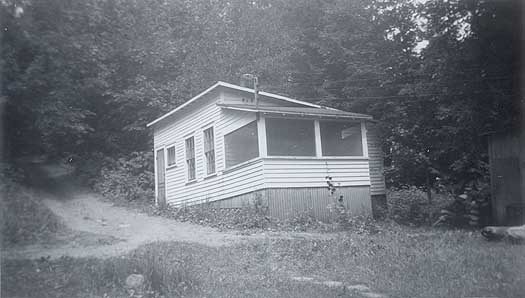
The “Loafing Lodge” after add-ons – looking away from lake toward road
Albert’s son Carl bought property just north of Albert in the late 1930s and developed it in a manner similar to what Albert did. He started with a basic cottage and in about 1943-44 added more to make a comfortable residence. In about 1947, Carl built and opened a pick-up store on the road. He may have had a small coffee shop and he may have sold gas, but he definitely had an icehouse that he filled by cutting Lake Gogebic ice in the wintertime and covering it with sawdust from local sawmills. Thus insulated, the ice lasted well into the summertime.
The above are the “factual” memories of the Tillner cottages. Now for some stories that are subject to the quality of the memories of those who experienced them originally as well as the quality of the memories of those who eventually related them to this writer (and, I suppose, though I hate to admit it, even the memory of this writer).
Albert’s wife Fredrika was a wonderful cook and baker. She always had fresh bread around and frequently made Swedish limpa rye bread. In the summertime Fredrika kept the breadbox on the screen porch. One night after baking fresh limpa the peace was disturbed by noises on the screen porch. Fredrika and others got up to investigate and found that a bear had come through the screen and was trying to get at the bread. Rubie was upstairs and she started calling to the small cottage to warn Edna, Karlton, and Roland and to get help. Meanwhile Fredrika took her broom and stood at the door from the kitchen to the porch scourging the bear. Although the bear had come through the “window” screen, it headed straight for the screen door. The door opened in, but was very little impediment and the bear went right through it. It carried the breadbox up the driveway as far as the small cottage before abandoning it and escaping into the woods. John and Julia were visiting at the time also, and Julia insisted that they pack up and leave the next morning.
Albert did everything “reasonable” to make the boathouse and dock sturdy, but UP winters can be very harsh. One year the ice actually turned the boathouse 90°. In the springtime Albert found ways to winch the boathouse back to its original position. Testament to the strength of the boathouse is that it withstood a 90° displacement and return and was still functional!
Either that same year or another one the dock was torn up by ice. The log closest to the water was raised up, 1” bolts, boulders, sand, planks and all, and folded over the other log.
Fredrika was invariably the first one up in the morning. She would get a fire going in the wood range, fill the reservoir, put water on for coffee and wash up. Coffee was brewed in an open kettle slipped partway into the firepot through one of the round openings with the lid removed. Toast was made on a wire rack placed flat on the stovetop. When the fire was going well she would put two or three whole coffee beans on the top of the range. They would hop around and roast and fill the cottage with fresh coffee smell. I’ve been drinking coffee for many years all over the world, but I have never had coffee that tasted anywhere near as good as those coffee beans smelled!
One summer day everyone at the cottage except Fredrika headed out to pick raspberries. There are open spaces in the UP with no trees and the raspberries are rampant. We found a place that the bears hadn’t vacuumed yet and proceeded to fill every container. On the way back to the cottage we hatched a plan to “fool Grandma”. We lined up in youngest to oldest order, took smallest to largest containers in the same order and walked in. Each person told Grandma that his or her offering was the best we could do. Grandma was disappointed at first but quickly caught on and got into the spirit of it. The next day for lunch we had fresh homemade raspberry shortcake made all the sweeter for the experience of having picked it and “fooled Grandma”.
One summer night we all went out fishing. There was a very small creek (little more than a ditch) with just a few inches of water in it, but the elders swore we would catch fish. Indeed, the “crick” was full of brook trout. Aunt Stell (Margaret’s friend but Aunt to all of us) was with us and she was catching fish as fast as she could drop a hook in the water. I don’t remember what we used for bait, but it was potent. In retrospect, I can’t imagine why the fish would bite on anything we presented. If they would simply swim along the surface with their mouths open they would have more mosquitoes than they could eat! We all had fresh brook trout for breakfast the next morning.
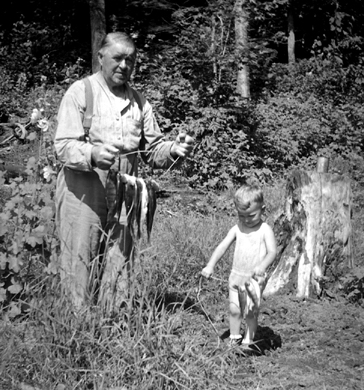
Grandpa Tillner and Pono with catch from lake ~1937
Karlton Lindberg (Edna’s husband) had TB and was in Grand View Hospital in those days. He was released for three months one summer to live at the cottage. A hospital bed was put on the screen porch, pull down shades were installed for bad weather, and Karlton slept there all summer. The therapeutic effects of the sun and fresh air were questionable. Edna and her son Roland spent all summer at the cottage for six or seven years during that time.
In the early days it was legal to leave setlines out overnight. Whoever was at the cottage would put out one line on each side of the boathouse. In the morning there was almost always a fish on each line. The fish would go in the live box for the next time the dinner menu called for them. Suddenly, the lines were found empty day after day. It was a mystery until one night when Karlton happened to wake up and hear a voice say, “There’s the boathouse”. He sat up in bed, couldn’t see anything because of the dark, but could hear activity by the boathouse. He shouted “What are you guys doing down there?” and then heard nothing but the unmistakable, rapid slap, slap, slap of a retreating boat. Inspection in the morning showed they had already taken the fish but cut the lines when threatened. Albert’s handgun was brought to the lake to frighten off the thieves but was never needed. The “slap, slap” never came back and the setlines started working again.
Seems to me that there were always people at the cottage. Ruby, Myron, and Edna lived nearby and spent lots of time there. Carl had the cottage next door. Beda, Margaret, Viola, and John lived in the Chicago area, but often vacationed at the lake. My folks and I got there for brief periods nearly every summer, but those times were golden.
On mild days life centered around the huge table on the screened porch. Aunt Rubie, Aunt Marge, and Auntie ‘Ola were always ready for double solitaire or Old Maid or whatever our age at that time allowed. The adults had coffee or drinks and endless conversation. The only break was at meal time when a great upheaval occurred, the table was set, the food was brought out, stragglers were rounded up, and we all ate at the same time. Unusual concept, ‘eh?
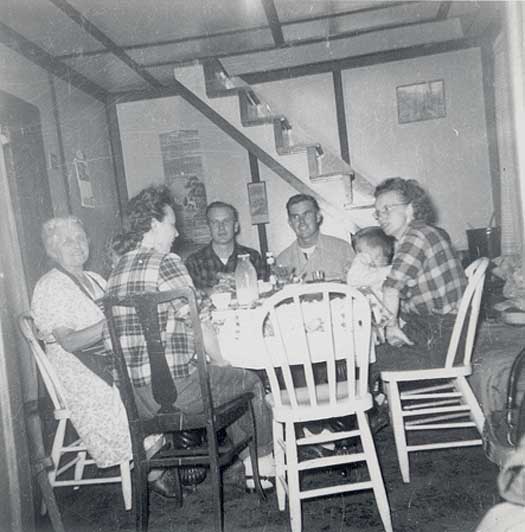
Grandma Tillner with a small subset of the gang ~1948
–
must have been rainy on the screen porch because
everyone was in the 15’ x 15’ room that started it all
Mornings and cooler days the kitchen was the hub. The hissing of the fire in the wood range, the smell of cooking and coffee, the warmth of the fire, all filled the senses with comfort and made life wonderful.
In the late ‘30s (still depression years), lots of people were staying at their cottages and the County Park had tenters galore. Roland remembers counting over 100 tents one time. Harold Ormes had the Red & White Store in Marenisco. He started a lake route and came to each cottage Monday, Wednesday and Friday. He had a panel truck with shelves built on each side and carried milk, butter, eggs, lard, canned goods, etc. You could order meat or whatever you needed on one visit and he would bring it the next time. Some prices from Roland’s memory: lard 7˘/lb, butter 23˘/lb, milk 10˘/qt, bread 10˘/loaf, and Kool-Aid 5˘/envelope. He always had a full truck, but very little produce other than potatoes.
“White City” was the first resort built on the south end of the lake. I think my folks used to call it “The White House”. It had a gravel road that led south through the woods to Gogebic Station. Gogebic Station was a small settlement on the east-west running railroad. That gravel road is referred to as “Stagecoach Road”. It is the scene of the last stagecoach robbery in the US east of the Mississippi River.
In those days there were lots of rowboats on the lake fishing and funning. Some had windup Victrolas with records playing and music carrying across the water. At night you could hear owls hooting and often wolves howling.
From the lake and from the east shore, the hills on the west side of the lake had the appearance of an alligator at rest. “Alligator’s Eye” was a popular hiking destination.
I remember the concept of “cottage-on-the-lake (COTL)” in terms of “different-from-home”. Home consists of work/school, store nearby, convenience, neighbors nearby, dry land. COTL consists of play, take-everything-you-need-along, outdoor plumbing, disconnect from other people, connect with family, and always the lake. Tillner’s cottage on Lake Gogebic was always full of aunts, uncles, cousins, nieces, nephews, grandparents, parents, siblings, and FUN! Card games, drinking, joking, swimming, fishing, boating, laughing, telling stories, remembering, eating, swinging on the porch, picking raspberries, chasing bears, hiking up to Alligator’s Eye, bedding down all together in cramped quarters, farting and laughing some more, finally drifting off to sleep, smelling the coffee beans Grandma put on the wood range in the morning, and then getting up and doing it all again. People probably still have fun at cottages, but TV, electricity, plumbing, foul weather gear, bug spray, fishing and hunting licenses, smaller families, and dispersion of families has changed things. I miss the wood range, the coffee beans dancing on it, the two-holer where Lolly (Roland) and I shared a poop and a rhyme, the ever-ready aunts, swimming in the icy water until our lips turned blue, picking raspberries until every pail was full, catching brook trout until we couldn’t carry any more, hearing the stories of earlier summers from the adults as I got sleepy in the evenings, feeling the warmth of the kitchen on a crisp morning. I wish I could bottle these memories. There must be a market for them. Maybe I could sell them to folks sitting in their “homes-on-the-lake” pretending they have “cottages-on-the-lake”.
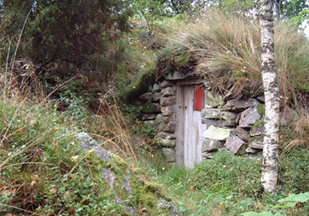
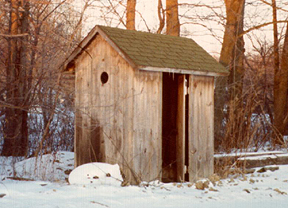
|
Root Cellar |
Two-holer |
|
|
|
|
The root cellar looks very much like the one at the Tillner cottage, but both pictures are simply representative of the breed.
|
|
By Norm “Pono” Sandin with lots of help from first cousin Roland “Lolly” Lindberg
[Visitor number
]
